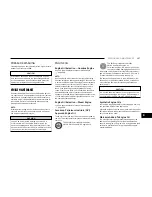
•
Ethanol blends are not recommended or approved
for use with your Cummins® diesel engine.
•
In addition, commercially available fuel additives are
not necessary for the proper operation of your
Cummins® diesel engine.
INTERVENTION REGENERATION
STRATEGY — MESSAGE PROCESS
FLOW
The Cummins® diesel engine meets all Environmental
Protection Agency (EPA) Heavy Duty Diesel Engine Emis-
sions Standards, resulting in one of the lowest emitting
diesel engines ever produced.
To achieve these emissions standards, your vehicle is
equipped with a state-of-the-art engine and exhaust
system. The engine and exhaust after-treatment system
work together to achieve the EPA Heavy Duty Diesel
Engine Emissions Standards. These systems are seam-
lessly integrated into your vehicle and managed by the
Cummins® Powertrain Control Module (PCM). The PCM
manages engine combustion to allow the exhaust sys-
tem’s catalyst to trap and burn Particulate Matter (PM)
pollutants, with no input or interaction on your part.
If the engine is allowed to idle or the truck is driven on
low engine speed drive cycles for more than two hours,
the system will automatically enter an emissions oper-
ating mode that will increase the engine idle speed to
1,050 RPM. While in this mode, which is designed to
help maintain the Diesel Particulate Filter, the engine
idle speed will return to normal when the brake pedal is
applied. A small change in engine tone or a slight
change in engine performance while accelerating may
also be noticeable at speeds below 20 mph (32 km/h).
This operating mode may last for up to an hour of idle
time, or around 20 minutes of driving time.
Additionally, your vehicle has the ability to alert you to
additional maintenance required on your truck or
engine
WARNING!
A hot exhaust system can start a fire if you park over
materials that can burn. Such materials might be
grass or leaves coming into contact with your exhaust
system. Do not park or operate your vehicle in areas
where your exhaust system can contact anything that
can burn.
DIESEL EXHAUST FLUID (DEF)
DEF sometimes known simply by the name of its active
component, UREA, is a key component of Selective
Catalytic Reduction (SCR) systems, which help diesel
vehicles meet stringent emission regulations. DEF is a
liquid reducing agent that reacts with engine exhaust in
the presence of a catalyst to convert smog-forming
nitrogen oxides (NOx) into harmless nitrogen and water
vapor
You can receive assistance in locating DEF by contact-
ing an authorized dealer.
BODY LUBRICATION
Locks and all body pivot points, including such items as
seat tracks, door hinge pivot points and rollers, liftgate,
tailgate, decklid, sliding doors and hood hinges, should
be lubricated periodically with a lithium-based grease,
such as Mopar® Spray White Lube to ensure quiet,
easy operation and to protect against rust and wear.
Prior to the application of any lubricant, the parts con-
cerned should be wiped clean to remove dust and grit;
after lubricating excess, oil and grease should be
removed. Particular attention should also be given to
hood latching components to ensure proper function.
When performing other underhood services, the hood
latch, release mechanism and safety catch should be
cleaned and lubricated.
The external lock cylinders should be lubricated twice a
year, preferably in the Autumn and Spring. Apply a small
amount of a high quality lubricant, such as Mopar®
Lock Cylinder Lubricant directly into the lock cylinder.
WINDSHIELD WIPER BLADES
Clean the rubber edges of the wiper blades and the
windshield periodically with a sponge or soft cloth and
a mild nonabrasive cleaner. This will remove accumula-
tions of salt or road film.
Operation of the wipers on dry glass for long periods
may cause deterioration of the wiper blades. Always
use washer fluid when using the wipers to remove salt
or dirt from a dry windshield.
Avoid using the wiper blades to remove frost or ice from
the windshield. Keep the blade rubber out of contact with
petroleum products such as engine oil, gasoline, etc.
NOTE:
Life expectancy of wiper blades varies depending on
geographical area and frequency of use. Poor perfor-
mance of blades may be present with chattering,
marks, water lines or wet spots. If any of these condi-
tions are present, clean the wiper blades or replace as
necessary.
The wiper blades and wiper arms should be inspected
periodically, not just when wiper performance problems
are experienced. This inspection should include the
following points:
•
Wear or uneven edges
•
Foreign material
SERVICING AND MAINTENANCE
295
8
Содержание CHASSIS CAB 2024
Страница 69: ...GETTING TO KNOW YOUR INSTRUMENT PANEL MIDLINE INSTRUMENT CLUSTER GASOLINE 67 3...
Страница 71: ...HIGHLINE INSTRUMENT CLUSTER GASOLINE GETTING TO KNOW YOUR INSTRUMENT PANEL 69 3...
Страница 75: ...MIDLINE INSTRUMENT CLUSTER DIESEL GETTING TO KNOW YOUR INSTRUMENT PANEL 73 3...
Страница 77: ...HIGHLINE INSTRUMENT CLUSTER DIESEL GETTING TO KNOW YOUR INSTRUMENT PANEL 75 3...
Страница 357: ......
Страница 358: ......






































